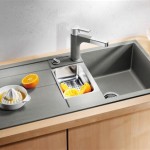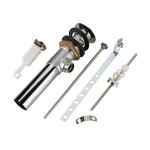Stainless Steel Smart Divide Sink: A Comprehensive Overview
The stainless steel smart divide sink represents a modern innovation in kitchen design, offering a unique combination of functionality, durability, and aesthetic appeal. Unlike traditional single-bowl or double-bowl sinks, the smart divide sink incorporates a lower divider between the two bowls. This design facilitates the handling of large pots and pans, while still maintaining the benefits of a divided sink for multitasking. The inherent properties of stainless steel, coupled with the innovative divide design, make this sink a popular choice for contemporary kitchens.
The construction of a stainless steel smart divide sink typically involves using 16-gauge or 18-gauge stainless steel. The gauge refers to the thickness of the steel; a lower gauge number indicates a thicker, more durable material. 304-grade stainless steel is commonly used due to its resistance to corrosion, rust, and staining. This grade contains chromium and nickel, which contribute to its protective properties. The sink's surface is often treated with a brushed or satin finish to minimize the visibility of scratches and water spots, enhancing its overall appearance and ease of maintenance.
Installation options for stainless steel smart divide sinks are versatile, encompassing undermount, drop-in (top-mount), and farmhouse (apron-front) styles. Undermount sinks are installed beneath the countertop, creating a seamless transition and facilitating easy cleaning. Drop-in sinks are installed from above, with the rim resting on the countertop. Farmhouse sinks feature an exposed front, adding a distinctive architectural element to the kitchen. The choice of installation method depends on the countertop material, kitchen design, and personal preferences.
Enhanced Functionality and Versatility
The primary advantage of the smart divide design lies in its enhanced functionality and versatility. The lower divider allows users to accommodate large items, such as baking sheets or stockpots, which would typically be difficult to maneuver in a standard double-bowl sink. One side can be used for washing dishes, while the other is used for rinsing or food preparation, thereby improving efficiency in the kitchen. The design caters to both small and large cleaning tasks with relative ease.
Furthermore, the smart divide sink can be incredibly helpful for specific tasks. For instance, during food preparation, one side can hold vegetables being washed, while the other side can collect scraps and peels. After a meal, the larger bowl can accommodate bulky pots and pans, while the smaller bowl can be used for rinsing smaller items. This segregation of tasks helps to maintain a cleaner and more organized workspace. Some models also include accessories such as cutting boards or colanders that fit snugly across the sink, creating an integrated workstation.
The depth of the bowls is also a significant consideration. Deeper bowls can accommodate larger items and minimize splashing. However, excessively deep bowls can be uncomfortable for some users, potentially causing back strain. Therefore, selecting a sink with an appropriate bowl depth is crucial for ergonomic comfort and usability.
Durability and Maintenance
Stainless steel is renowned for its durability and resistance to damage. It withstands high temperatures, does not chip or crack easily, and is relatively impervious to staining from food and beverages. The 304-grade stainless steel commonly used in smart divide sinks offers excellent corrosion resistance, ensuring that the sink retains its appearance and functionality over time. With proper care, a stainless steel smart divide sink can last for many years.
Maintaining a stainless steel sink is relatively simple. Regular cleaning with mild soap and water is generally sufficient to remove food particles and prevent the buildup of grime. Abrasive cleaners should be avoided, as they can scratch the surface. A soft cloth or sponge is recommended for cleaning to minimize the risk of damage. Specialty stainless steel cleaners can be used to remove stubborn stains and maintain the sink's shine.
Water spots can be a common issue with stainless steel sinks. Drying the sink after each use can help to prevent water spots from forming. Alternatively, a stainless steel polish can be applied periodically to create a protective barrier and reduce the appearance of water spots. Proper maintenance not only preserves the sink's appearance but also extends its lifespan.
Aesthetic Considerations and Design Integration
Stainless steel is a versatile material that complements a wide range of kitchen styles, from modern and minimalist to traditional and farmhouse. The sleek, metallic finish of stainless steel adds a touch of elegance to any kitchen. The neutral tone of stainless steel allows it to blend seamlessly with various countertop materials, cabinet finishes, and appliance colors.
The shape and configuration of the smart divide sink should be carefully considered to ensure that it aligns with the overall kitchen design. Rectangular sinks are a popular choice for modern kitchens, while curved or rounded sinks can add a softer touch to more traditional spaces. The placement of the drain is another important factor. Center drains are common, but offset drains can provide more usable space within the sink bowls. The sink's size should be proportionate to the countertop area and the overall dimensions of the kitchen.
Furthermore, the faucet selection plays a crucial role in the overall aesthetic. Stainless steel faucets are a natural complement to stainless steel sinks, but other finishes, such as chrome or brushed nickel, can also be used to create a visually appealing contrast. The faucet's design should complement the sink's shape and style. High-arc faucets are often preferred for their functionality, providing ample clearance for filling large pots and pans. A pull-down or pull-out sprayer can also enhance the sink's versatility, making it easier to rinse dishes and clean the sink itself.
In summary, the stainless steel smart divide sink represents a well-engineered and aesthetically pleasing addition to any modern kitchen. Its functionality extends beyond traditional sinks by offering the convenience of segregated bowls with the flexibility to accommodate larger items, making it a practical and enduring choice for discerning homeowners.
Beyond its functional merits, the choice of accessories can further optimize the sink's utility. Fitted cutting boards, colanders, and drying racks can transform the sink into a comprehensive food preparation station. These additions not only save counter space but also streamline the workflow. The availability of custom-designed accessories for specific sink models enhances the user experience and elevates the overall functionality of the smart divide sink.
The sound dampening qualities of stainless steel sinks are also worth noting. High-quality sinks often feature sound-deadening pads or coatings applied to the underside of the bowls, which minimize noise from running water and clanging dishes. This feature contributes to a quieter and more pleasant kitchen environment. The presence of sound dampening is a sign of quality construction and attention to detail.

32 Low Divide Offset Undermount Stainless Steel Double Bowl Kitchen S

B1616 Low Divide Undermount Stainless Steel Kitchen Sink 20 Mm Corners

Elkay Workstation Ss 31 5 X 18 9 Equal Dbl Undermount Sink Kit

Lustertone Stainless Double Bowl Undermount Sink With Aqua Divide Elkay

Stylish Olivine S 202xtg 32 Dual Mount Double Bowl Stainl

Giagni Divide A Bowl Dual Mount 33 In X 22 Stainless Steel Single Kitchen Sink At Com

Ruvati 33 Low Divide Undermount 40 60 Double Bowl Kitchen Sink Rvh7418

Ruvati 29 Inch Undermount 50 Double Bowl 16 Gauge Stainless Steel Kitchen Sink Rvm4301 Usa

Stylish S 601wn 32 Inch Double Bowl Undermount 16 Gauge Stainless Steel Kitchen Sink With Accessories Black

Ruvati 32 50 Double Bowl Undermount 16 Gauge Kitchen Sink Rvm4350 1759







